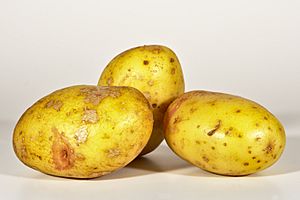King Edward potato facts for kids
Quick facts for kids King Edward |
|
|---|---|

King Edward
|
|
| Genus | Solanum |
| Species | Solanum tuberosum |
| Cultivar | 'King Edward' |
| Breeder | John Butler |
| Origin | Scotter, Lincolnshire, Britain 1902 |
The King Edward potato is a very old and popular type of potato grown in the UK. It has been around since 1902, which makes it one of the oldest kinds of potatoes still grown and sold today!
Contents
What Does the King Edward Potato Look Like?
This potato has a mostly white skin with pretty pink patches. It's usually oval-shaped. Inside, it has a soft, floury texture, which means it gets light and fluffy when cooked. It also has "shallow eyes," which are the small dents where new sprouts can grow.
The King Edward plant itself grows tall and straight. It has many stems and small green leaves. When it blooms, you'll see lovely purple flowers with white tips.
The History of the King Edward Potato
The exact "parents" of the King Edward potato are a bit of a mystery. We know it was first grown by a gardener in Northumberland, England. This gardener called it 'Fellside Hero'.
How the Potato Got Its Name
The potato was passed from one person to another. Eventually, it ended up with a man named John Butler in Scotter, Lincolnshire. He saw how good this potato was! He bought all the available seeds and grew a lot of them on about 50 acres of land.
A potato seller suggested he rename the potato. In 1902, King Edward VII became king. It's believed the potato was named 'King Edward' to celebrate this special event. Some even say the grower wrote to Buckingham Palace and got permission from the King himself! This potato is one of the oldest types of potatoes still grown in Europe.
Growing King Edward Potatoes
The King Edward potato is a "main crop" potato. This means it takes longer to grow than some other types. In the UK, people usually plant them in April. They are then ready to be harvested in September.
Where Can You Grow Them?
You can grow King Edward potatoes in large farms for selling. They are also great for smaller gardens or allotments. Allotments are small plots of land that people rent to grow their own food.
Potato Health
This potato type is quite strong against a common problem called common scab. It also has some protection against potato blight, which is a serious plant disease. However, it can be affected by tiny worms called potato cyst nematode.
Cooking with King Edward Potatoes
The King Edward potato is famous for its light and fluffy texture when cooked. This makes it perfect for many dishes!
Best Ways to Cook Them
- Roasting: They get wonderfully crispy on the outside and fluffy inside.
- Mashed Potato: They mash up smoothly and are very light.
- Baking: A baked King Edward potato is soft and delicious.
You can also use them for chipping (making chips or fries), sautéing (frying quickly in a little oil), or steaming. The famous chef Delia Smith even said they are the best potatoes to use for making gnocchi, which are soft Italian dumplings.

